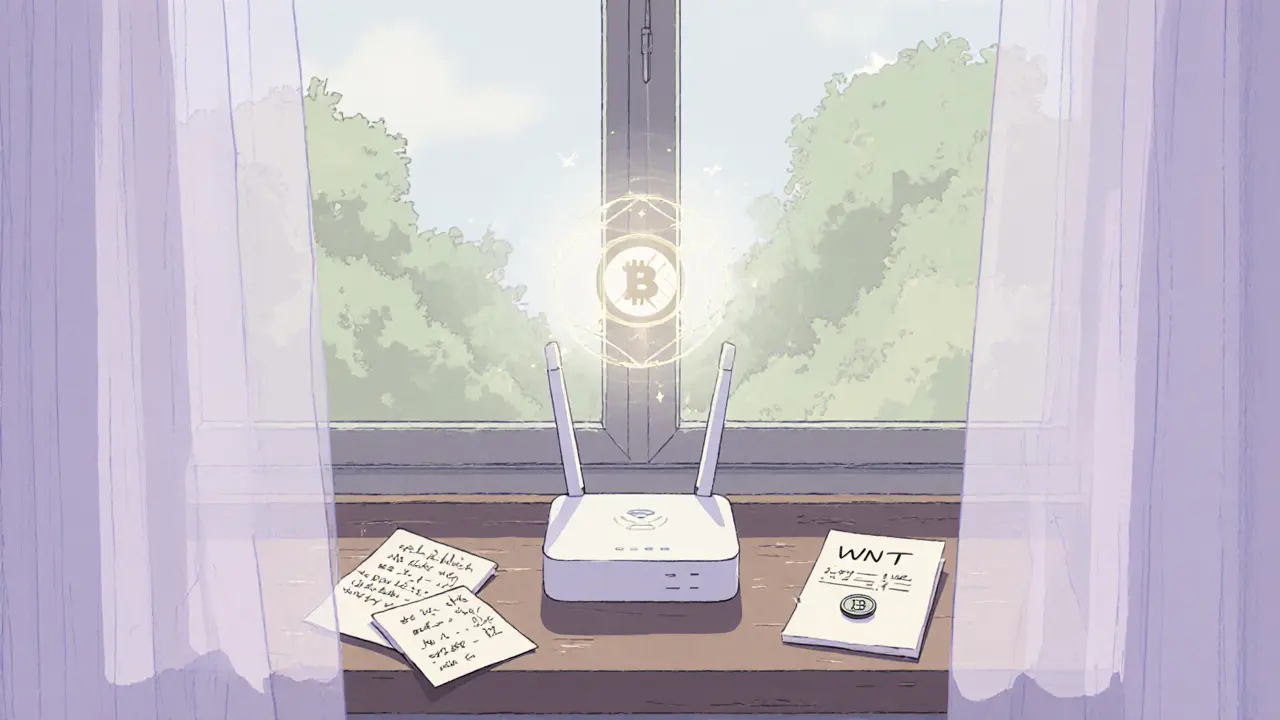
Wicrypt Earnings Calculator
Estimate Your Wicrypt Earnings
Calculate potential earnings based on historical data from the Wicrypt network (2021-2022)
Results will appear here after calculation
Note: These calculations are based on historical data from the Wicrypt network. Actual earnings in 2021-2022 were highly variable due to network demand, device performance, and token price fluctuations.
How It Worked
Wicrypt required a $99 router purchase with token rewards based on bandwidth sharing. Tokens were locked for 36 months.
- $3.50 Typical daily earnings (Reported by users in Lagos, Nigeria)
- 18h Max uptime (Limited by device heating)
- 36mo Token vesting period (Only partial unlocks were released)
Why This Matters
The Wicrypt project failed because the actual earnings were far lower than expectations when accounting for token value and vesting schedules.
Back in 2021, Wicrypt promised something simple: plug in a device, share your Wi-Fi, and get paid in WNT tokens. No mining rigs. No complex staking. Just your home internet doing double duty. It sounded like a no-brainer-especially in places where data was expensive and unreliable. But what happened to the Wicrypt NFT & Device Drop airdrop? And why are people talking about it like a ghost story now?
It Wasn’t Really an Airdrop
First, let’s clear up a big misunderstanding. Wicrypt never ran a traditional airdrop where you just sign up and get free tokens. The so-called "NFT & Device Drop" wasn’t a giveaway-it was a device sale with token rewards baked in. You had to pay $99 for the Wicrypt router. In return, you got access to the network and earned WNT tokens based on how much bandwidth you shared. The "NFT" part? That was just a digital certificate of ownership for your device, not a collectible or a utility NFT like those in games or metaverses. It didn’t unlock special features. It didn’t give you voting rights. It was essentially a receipt with a blockchain stamp.How the System Actually Worked
The Wicrypt device was a small white router, similar to a standard home Wi-Fi unit but with a twist: it ran a lightweight blockchain node. When you plugged it in, it shared a portion of your internet connection with nearby users in the Wicrypt network. In return, you earned WNT tokens. The more uptime you had, the more you earned. It was designed to work best in dense urban areas-places like Lagos, Nairobi, or Jakarta-where people needed affordable internet but couldn’t afford high monthly plans. Earnings weren’t guaranteed. They depended on demand. One Reddit user in Lagos reported making about $3.50 a day in late 2021. That’s not life-changing, but in a market where average monthly income was $150, it was meaningful. Others weren’t so lucky. Devices overheated in tropical heat. Some rebooted randomly. Shipping delays stretched to eight weeks. And if you lived outside Nigeria or a few other African countries? You couldn’t even order one.The Tokenomics: Locked Up and Slow to Release
WNT tokens weren’t handed out all at once. The team structured the distribution to prevent a crash. Only a small portion unlocked immediately after device activation. The rest? Locked up for 36 months. That meant if you bought a device in January 2022, most of your tokens wouldn’t be yours to sell until late 2024. This was meant to align incentives-keep people running the device long-term. But it backfired. When tokens finally started unlocking in 2023, there was no demand. The price had already collapsed. People who held onto their tokens for years ended up with digital assets worth pennies. WNT launched on Cardano’s OccamRazer launchpad in October 2021. It briefly traded on a few decentralized exchanges. But by mid-2022, liquidity vanished. CoinGecko delisted it. No major exchange ever listed it. The token had no real use case beyond the network-and the network never scaled.
Why It Failed When Helium Didn’t
Helium, another decentralized wireless project, raised over $100 million and deployed half a million hotspots globally. Wicrypt? Around 1,200 devices ever shipped. Why the difference? Helium used LoRaWAN-a low-power, long-range wireless protocol designed for IoT sensors. It didn’t need to compete with home internet. It served smart meters, trackers, and weather stations. Wicrypt tried to compete with MTN, Airtel, and Vodafone on their own turf: affordable home Wi-Fi. That’s a brutal fight. You need massive infrastructure, customer support, and regulatory approval. Wicrypt had none of that. Plus, Helium’s token was easy to mine with cheap hardware. Wicrypt required you to buy a $99 device, ship it across continents, and hope it worked in your climate. The barrier to entry was too high for mass adoption.The NFT Part? Just a Digital Receipt
The "NFT" in the campaign name was misleading. It wasn’t a collectible. It wasn’t a key to future features. It was a blockchain-based proof that you owned a specific device. Think of it like a serial number on a receipt-but stored on-chain. No one could resell it as an asset. No one could trade it. It had no value outside the Wicrypt ecosystem. And when the ecosystem died, so did the NFT.What Happened to the Team?
The founders-Olayinka Okereke and Adeyinka Adebayo-were credible. Okereke came from Andela and Microsoft. Adebayo had worked at Google. That gave the project early trust. But after the initial push, updates stopped. GitHub commits dried up after March 2022. The official Telegram group shrank from 8,500 members to under 1,200. Customer support, once praised for quick replies, vanished. No announcements. No roadmap. No new devices. Just silence. By 2023, analysts at Messari called Wicrypt a textbook example of a "hardware-dependent blockchain failure." Over 70% of similar projects died within 18 months. Wicrypt lasted 15.
Is There Any Value Left?
Short answer: no. If you still have a Wicrypt device, it’s just a router. It won’t connect to the network anymore. The WNT token is worthless on any exchange. The NFT is a digital artifact with no function. The only thing left is the memory of what it was supposed to be-a decentralized alternative to expensive internet. Some former users still talk about it on Reddit and Telegram. "I wish it had worked," one wrote in October 2025. "I believed in it. But no one built the infrastructure to make it real."What You Can Learn From This
Wicrypt’s story isn’t just about a failed project. It’s a lesson in how not to do a blockchain airdrop or device campaign.- Don’t call a device sale an airdrop. It confuses people and sets false expectations.
- Don’t lock up tokens for 36 months unless you’re sure the network will survive that long.
- Don’t rely on hardware sales to fund a crypto project. People don’t buy crypto for routers-they buy it for returns.
- Don’t ignore regulation, logistics, and local market conditions. Wicrypt succeeded in Nigeria because the need was real. But it never expanded.
What’s Next for Decentralized Wi-Fi?
The problem Wicrypt tried to solve-expensive, unreliable internet in emerging markets-is still there. And it’s growing. But no one has cracked it yet. New projects are emerging, but they’re learning from Wicrypt’s mistakes. Some are focusing on software-only solutions. Others are partnering with local telecoms instead of trying to replace them. A few are even exploring satellite-backed mesh networks. Wicrypt didn’t fail because the idea was bad. It failed because execution was rushed, scalability was ignored, and the team vanished when things got hard. If you’re looking for a similar opportunity today? Don’t buy a device. Don’t chase an NFT. Look for projects with real partnerships, active development, and transparent metrics. And if it sounds too good to be true? It probably is.Was the Wicrypt NFT & Device Drop a real airdrop?
No, it wasn’t a traditional airdrop. You had to pay $99 for a physical router to join. The "NFT" was just a digital proof of ownership, not a free token giveaway. The WNT tokens were earned by sharing bandwidth, not claimed for free.
Can I still earn WNT tokens today?
No. The Wicrypt network shut down in early 2022. The servers are offline, the token is delisted, and the devices no longer connect. Any WNT tokens you might still have are worthless.
What happened to the Wicrypt devices?
They still work as regular Wi-Fi routers, but they can no longer connect to the Wicrypt blockchain network. Without the network, they can’t earn tokens. Many users repurposed them as backup routers or donated them.
Why did Wicrypt fail when Helium succeeded?
Helium targeted IoT sensors with low-power wireless, which didn’t compete with home internet providers. Wicrypt tried to replace traditional Wi-Fi providers-something that requires massive infrastructure, customer support, and regulatory approval. Wicrypt lacked both the funding and the operational scale to compete.
Is there any way to recover my WNT tokens or NFT?
No. The Wicrypt network is inactive. There is no official platform to access your wallet or claim assets. The project’s GitHub and social channels have been abandoned since 2022. Treat your WNT and NFT as lost assets.
Are there any similar projects still active today?
Not in the same form. Some newer projects are exploring decentralized Wi-Fi using software-only models or partnering with local ISPs. But no project has yet replicated the hardware-based model successfully. Most have shifted away from physical devices due to the high costs and low adoption rates seen with Wicrypt and Helium.






